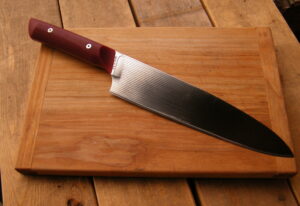 Henry Ford wrote in his 1922 autobiography,
Henry Ford wrote in his 1922 autobiography,
“Any customer can have a car painted any color that he wants so long as it is black.”
Have you ever noticed that kitchen knife handles seem to be predominantly black? To test my observation I searched a number of terms on google images and then counted what I found. I was trying to see how predominant black was as a handle color depending on the type of knife I was searching. I wasn’t looking for any other color in particular just black and non black. I scanned through the returned images, including the image in my count as long as it was unambiguous in terms of handle color. I did not take into account images with multiple knives unless they all had the same handle color. I also required that the image quality be good enough that I could reasonably tell if the handle was black vs a dark shade of some other color. Of the acceptable images, they would count as black so long as the majority of the handle was black. I based my black to non black ratios out of 50 acceptable images.
Here are my results, ranked highest to lowest in terms of percentage of black knives.
Google Search Term/Percentage of Black Knives
Chef’s knife/82%
German chef’s knife/78%
Camping knife/40%
Butcher’s knife/34%
Hunting knife/26%
Japanese chefs knife/22%
Folding knife/12%
Though there are a few mild surprises here, most of the results have some sort of explanation. The Chef’s and German chef’s results probably reflect a good amount of tradition. Bakelite, the first true synthetic plastic, was used in cookware and knife handles because of its waterproof and melt-proof properties, and was often black, perhaps because it aged more gracefully than other colors. Germans are known for their practicality and appreciation for sanitation, which made it natural for them to utilize the early non-absorbent synthetics. As for Japanese chef’s knives, they still tend toward wood and other traditional natural materials.
One of the bigger surprises here was the low ratio of black I found in butchers’ knives. The majority of such knives seem to have plastic handles, making color a ready option. I did note that many are white, yellow and blue and saw that at least one manufacturer follows a color code, whereby different bright colors represent the knife’s intended use for specific meat and fish and vegetable products. Wood, though a traditional choice, is not as likely to repel stains and germs under day-in, day-out service in a butcher shop.
Camping and hunting knives, though they may be called on to deal with bloody game and fish, probably spend a lower percentage of their time around water and food than kitchen knives. This allows wood to be used more often and even makes para-cord wrapping feasible. These knives are often either sold for applications where bright colors make them easier to locate or where camouflage is required; black being non-optimal in both cases.
The handles on folding knives often expose their minimally adorned metal frames as a feature. Or they attach other eye catching materials over top, whether functional or decorative. Folders are everything but traditional. Even Swiss Army Knives ship in black only a fraction of the time.
I was looking through a knife specialty store in Vancouver last year and discovered that they had a great deal on a Wusthof white handled chef’s knife.
“Why is it on sale?” I wondered.
“We’re clearing them out because a lot of people won’t buy a white knife,” was the answer.
“Yeah, well I guess they stain more easily,” I offered.
“Actually, no, they are guaranteed not to stain,” the saleswoman replied.
If that is true, then what else can it be but a conservative aversion to color or an association between colorful knives and cheap quality? I suspect it is both.
My particular inclination: color is good fun, so long as you know that you’re still getting top knife specs, if that is what you want. We recently had a customer order 3 of our Salal Chef’s knives. She chose 3 of our 4 available colors. The one she didn’t choose: the black model. Good for her!
Those are just some of my musings. I’d love to hear what you all think. You can add your comments below. Use whatever name you like. Your email will not be shown when your comment is displayed.

darelldd
Color IS good fun! But I’ve often heard the same common response: colored handles indicate cheap knives. Including hearing it just now from my wife! :-(. Keep reading for how to change her mind.
The idea of having color-coded handles is enticing to me. I’m tired of having nothing but black handles bristling from my knife block. Everything works out OK until a visitor (or wife!) mis-files one of the tools. I’d love nothing more than to be able to ID the knife with a glance, even in low light.
And my final thought: I think North Arm needs a brand color. And that color should be purple! Because if there is ONE way to bring my wife around to colored handles for high-quality knives, it’ll be with purple.
Cheers, and thank you for these fun blog entries!